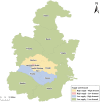Urban-sub-urban-rural variation in the supply and demand of emergency medical services
- PMID: 36761335
- PMCID: PMC9905235
- DOI: 10.3389/fpubh.2022.1064385
Urban-sub-urban-rural variation in the supply and demand of emergency medical services
Abstract
Background: Emergency medical services (EMSs) are a critical component of health systems, often serving as the first point of contact for patients. Understanding EMS supply and demand is necessary to meet growing demand and improve service quality. Nevertheless, it remains unclear whether the EMS supply matches the demand after the 2016 healthcare reform in China. Our objective was to comprehensively investigate EMS supply-demand matching, particularly among urban vs. sub-urban vs. rural areas.
Methods: Data were extracted from the Tianjin Medical Priority Dispatch System (2017-2021). From supply and demand perspectives, EMS resources and patient characteristics were analyzed. First, we performed a descriptive analysis of characteristics, used Moran's I to explore the spatial layout, and used the Gini coefficient to evaluate the equity of EMS supply and demand. Second, we analyzed urban-sub-urban-rural variation in the characteristics of EMS supply and demand by using the chi-square test. Finally, we examined the association between the EMS health resource density index and the number of patients by using the Spearman correlation and divided supply-demand matching types into four types.
Results: In 2021, the numbers of medical emergency stations and ambulances were 1.602 and 3.270 per 100,000 population in Tianjin, respectively. There were gradients in the health resource density index of the number of emergency stations (0.260 vs. 0.059 vs. 0.036; P = 0.000) in urban, sub-urban, and rural areas. There was no spatial autocorrelation among medical emergency stations, of which the G values by population, geographical distribution, and the health resource density index were 0.132, 0.649, and 0.473, respectively. EMS demand was the highest in urban areas, followed by sub-urban and rural areas (24.671 vs. 15.081 vs. 3.210 per 1,000 population and per year; P = 0.000). The EMS supply met the demand in most districts (r = 0.701, P = 0.003). The high supply-high demand types with stationary demand trends were distributed in urban areas; the low supply-high demand types with significant demand growth trends were distributed in sub-urban areas; and the low supply-low demand types with the highest speed of demand growth were distributed in rural areas.
Conclusion: EMS supply quantity and quality were promoted, and the supply met the demand after the 2016 healthcare reform in Tianjin. There was urban-sub-urban-rural variation in EMS supply and demand patterns.
Keywords: emergency medical services; healthcare reform; healthcare resources; megacity; supply and demand matching.
Copyright © 2023 Li, Li, Geng, Liu, Liu, Fan and Cao.
Conflict of interest statement
The authors declare that the research was conducted in the absence of any commercial or financial relationships that could be construed as a potential conflict of interest.
Figures





Similar articles
-
Spatial accessibility of emergency medical services in Chongqing, Southwest China.Front Public Health. 2023 Jan 6;10:959314. doi: 10.3389/fpubh.2022.959314. eCollection 2022. Front Public Health. 2023. PMID: 36684945 Free PMC article.
-
The equity of China's emergency medical services from 2010-2014.Int J Equity Health. 2017 Jan 11;16(1):10. doi: 10.1186/s12939-016-0507-5. Int J Equity Health. 2017. PMID: 28077150 Free PMC article.
-
Examining sufficiency and equity in the geographic distribution of physicians in Japan: a longitudinal study.BMJ Open. 2017 Mar 14;7(3):e013922. doi: 10.1136/bmjopen-2016-013922. BMJ Open. 2017. PMID: 28292766 Free PMC article.
-
Organisational factors affecting emergency medical services' performance in rural and urban areas of Saudi Arabia.BMC Health Serv Res. 2021 Jun 7;21(1):562. doi: 10.1186/s12913-021-06565-3. BMC Health Serv Res. 2021. PMID: 34098943 Free PMC article. Review.
-
Factors Impacting Patient Outcomes Associated with Use of Emergency Medical Services Operating in Urban Versus Rural Areas: A Systematic Review.Int J Environ Res Public Health. 2019 May 16;16(10):1728. doi: 10.3390/ijerph16101728. Int J Environ Res Public Health. 2019. PMID: 31100851 Free PMC article.
Cited by
-
Revealing spatiotemporal inequalities, hotspots, and determinants in healthcare resource distribution: insights from hospital beds panel data in 2308 Chinese counties.BMC Public Health. 2024 Feb 9;24(1):423. doi: 10.1186/s12889-024-17950-y. BMC Public Health. 2024. PMID: 38336709 Free PMC article.
-
Spatial analysis of prehospital emergency medical services accessibility: a comparative evaluation of the GAUSS-probability two-step floating catchment area model in Handan City.Front Public Health. 2025 Mar 28;13:1548462. doi: 10.3389/fpubh.2025.1548462. eCollection 2025. Front Public Health. 2025. PMID: 40226325 Free PMC article.
-
The five-link theory for improving the integrated and balanced development of emergency medical care in urban and rural areas.J Glob Health. 2025 Jul 1;15:03023. doi: 10.7189/jogh.15.03023. J Glob Health. 2025. PMID: 40587197 Free PMC article.
References
-
- Fukushima H, Imanishi M, Iwami T, Seki T, Kawai Y, Norimoto K, et al. . Abnormal breathing of sudden cardiac arrest victims described by laypersons and its association with emergency medical service dispatcher-assisted cardiopulmonary resuscitation instruction. Emerg Med J. (2015) 32:314–7. 10.1136/emermed-2013-203112 - DOI - PMC - PubMed
Publication types
MeSH terms
LinkOut - more resources
Full Text Sources
Medical
Miscellaneous

